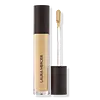Laura Mercier Flawless Fusion Ultra Longwear Concealer Versus Hourglass Cosmetics Vanish Airbrush Concealer
What's inside
What's inside
 Key Ingredients
Key Ingredients

 Benefits
Benefits

 Concerns
Concerns

 Ingredients Side-by-side
Ingredients Side-by-side

Water
Skin ConditioningCyclopentasiloxane
EmollientDodecane
PerfumingGlycerin
HumectantCetyl PEG/PPG-10/1 Dimethicone
EmulsifyingButylene Glycol
HumectantHeptyl Undecylenate
EmollientPhenyl Trimethicone
Skin ConditioningHydrogendimethylsiloxysilicate
Neopentyl Glycol Diheptanoate
EmollientBis-PEG/PPG-14/14 Dimethicone
EmollientSilica
AbrasiveQuaternium-90 Bentonite
Acrylates/C12-22 Alkyl Methacrylate Copolymer
Tribehenin
EmollientBoron Nitride
AbsorbentPolyglyceryl-3 Diisostearate
EmulsifyingLecithin
EmollientPentylene Glycol
Skin ConditioningDisodium Stearoyl Glutamate
CleansingDimethicone/Vinyl Dimethicone Crosspolymer
Skin ConditioningAscorbyl Glucoside
AntioxidantMagnesium Sulfate
Laureth-7
EmulsifyingPropylene Carbonate
SolventAluminum Dimyristate
Emulsion StabilisingTriethoxycaprylylsilane
Serica
HumectantTrisodium EDTA
Phenoxyethanol
PreservativeCaprylyl Glycol
EmollientChlorphenesin
AntimicrobialMica
Cosmetic ColorantCI 77891
Cosmetic ColorantCI 77491
Cosmetic ColorantCI 77492
Cosmetic ColorantCI 77499
Cosmetic ColorantWater, Cyclopentasiloxane, Dodecane, Glycerin, Cetyl PEG/PPG-10/1 Dimethicone, Butylene Glycol, Heptyl Undecylenate, Phenyl Trimethicone, Hydrogendimethylsiloxysilicate, Neopentyl Glycol Diheptanoate, Bis-PEG/PPG-14/14 Dimethicone, Silica, Quaternium-90 Bentonite, Acrylates/C12-22 Alkyl Methacrylate Copolymer, Tribehenin, Boron Nitride, Polyglyceryl-3 Diisostearate, Lecithin, Pentylene Glycol, Disodium Stearoyl Glutamate, Dimethicone/Vinyl Dimethicone Crosspolymer, Ascorbyl Glucoside, Magnesium Sulfate, Laureth-7, Propylene Carbonate, Aluminum Dimyristate, Triethoxycaprylylsilane, Serica, Trisodium EDTA, Phenoxyethanol, Caprylyl Glycol, Chlorphenesin, Mica, CI 77891, CI 77491, CI 77492, CI 77499
Water
Skin ConditioningCyclopentasiloxane
EmollientPhenyl Trimethicone
Skin ConditioningMica
Cosmetic ColorantButylene Glycol
HumectantCetyl PEG/PPG-10/1 Dimethicone
EmulsifyingPvp
Emulsion StabilisingPEG-10 Dimethicone
Skin ConditioningCI 77120
Cosmetic ColorantSodium Chloride
MaskingVinyl Dimethicone/Methicone Silsesquioxane Crosspolymer
Aluminum Hydroxide
EmollientCamellia Sinensis Leaf Extract
AntimicrobialCentella Asiatica Extract
CleansingChamomilla Recutita Flower Extract
MaskingDimethicone
EmollientDisteardimonium Hectorite
StabilisingGlycyrrhiza Glabra Root Extract
BleachingMethicone
EmollientMyristic Acid
CleansingPalmitic Acid
EmollientPolygonum Cuspidatum Root Extract
AntioxidantPolysilicone-11
Rosmarinus Officinalis Leaf Extract
AntimicrobialScutellaria Baicalensis Root Extract
AstringentSqualane
EmollientStearic Acid
CleansingTriethoxycaprylylsilane
Chlorphenesin
AntimicrobialPhenoxyethanol
PreservativeCI 77891
Cosmetic ColorantIron Oxides
Water, Cyclopentasiloxane, Phenyl Trimethicone, Mica, Butylene Glycol, Cetyl PEG/PPG-10/1 Dimethicone, Pvp, PEG-10 Dimethicone, CI 77120, Sodium Chloride, Vinyl Dimethicone/Methicone Silsesquioxane Crosspolymer, Aluminum Hydroxide, Camellia Sinensis Leaf Extract, Centella Asiatica Extract, Chamomilla Recutita Flower Extract, Dimethicone, Disteardimonium Hectorite, Glycyrrhiza Glabra Root Extract, Methicone, Myristic Acid, Palmitic Acid, Polygonum Cuspidatum Root Extract, Polysilicone-11, Rosmarinus Officinalis Leaf Extract, Scutellaria Baicalensis Root Extract, Squalane, Stearic Acid, Triethoxycaprylylsilane, Chlorphenesin, Phenoxyethanol, CI 77891, Iron Oxides
 Reviews
Reviews

Ingredients Explained
These ingredients are found in both products.
Ingredients higher up in an ingredient list are typically present in a larger amount.
Butylene Glycol (or BG) is used within cosmetic products for a few different reasons:
Overall, Butylene Glycol is a safe and well-rounded ingredient that works well with other ingredients.
Though this ingredient works well with most skin types, some people with sensitive skin may experience a reaction such as allergic rashes, closed comedones, or itchiness.
Learn more about Butylene GlycolThis ingredient is a high molecular weight silicone. It has emulsifying and skin conditioning properties.
Chlorphenesin is a synthetic preservative. It helps protect a product against bacteria in order to extend shelf life. In most cases, Chlorphenesin is paired with other preservatives such as phenoxyethanol and caprylyl glycol.
Chlorphenesin is a biocide. This means it is able to help fight the microorganisms on our skin. It is also able to fight odor-releasing bacteria.
Chlorphenesin is soluble in both water and glycerin.
Studies show Chlorphenesin is easily absorbed by our skin. You should speak with a skincare professional if you have concerns about using Chlorphenesin.
Learn more about ChlorphenesinCi 77891 is a white pigment from Titanium dioxide. It is naturally found in minerals such as rutile and ilmenite.
It's main function is to add a white color to cosmetics. It can also be mixed with other colors to create different shades.
Ci 77891 is commonly found in sunscreens due to its ability to block UV rays.
Learn more about CI 77891Cyclopentasiloxane, or D5, is a silicone used to improve texture of products and trap moisture.
D5 is considered lightweight and volatile. Volatile means it evaporates quickly after application. Once evaporated, D5 leaves a thin barrier that helps keep skin hydrated.
It is also an emollient. Emollients help soften the skin and prevent water loss. Silicones create a silky texture in products. D5 helps other ingredients become more spreadable.
Studies show D5 is safe to use in skincare products. We recommend speaking with a skincare professional if you have concerns.
Learn more about CyclopentasiloxaneMica is a naturally occurring mineral used to add shimmer and color in cosmetics. It can also help improve the texture of a product or give it an opaque, white/silver color.
Serecite is the name for very fine but ragged grains of mica.
This ingredient is often coated with metal oxides like titanium dioxide. Trace amounts of heavy metals may be found in mica, but these metals are not harmful in our personal products.
Mica has been used since prehistoric times throughout the world. Ancient Egyptian, Indian, Greek, Roman, Aztec, and Chinese civilizations have used mica.
Learn more about MicaPhenoxyethanol is a preservative that has germicide, antimicrobial, and aromatic properties. Studies show that phenoxyethanol can prevent microbial growth. By itself, it has a scent that is similar to that of a rose.
It's often used in formulations along with Caprylyl Glycol to preserve the shelf life of products.
Phenyl Trimethicone is a silicon-based polymer. It is derived from silica.
Phenyl Trimethicone is used as an emollient and prevents products from foaming.
As an emollient, it helps trap moisture in the skin. It is considered an occlusive.
Learn more about Phenyl TrimethiconeTriethoxycaprylylsilane is a silicone used to bind and stabilize ingredients.
As an emulsifier, it helps prevent ingredients from separating. This can help elongate the shelf life of products.
Triethoxycaprylylsilane is often used to coat mineral sunscreens ingredients to help give a better feel. It also helps reduce oxidative stress in sunscreens.
Learn more about TriethoxycaprylylsilaneWater. It's the most common cosmetic ingredient of all. You'll usually see it at the top of ingredient lists, meaning that it makes up the largest part of the product.
So why is it so popular? Water most often acts as a solvent - this means that it helps dissolve other ingredients into the formulation.
You'll also recognize water as that liquid we all need to stay alive. If you see this, drink a glass of water. Stay hydrated!
Learn more about Water